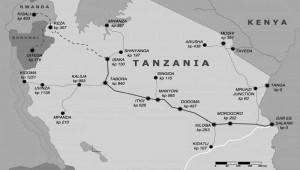by Ben Taylor
TAZARA trundles on
The troubled Tanzania-Zambia Railway (TAZARA) continues to struggle and the governments of Tanzania and Zambia have agreed to inject USD $80m into the jointly-owned network to improve operations. Tanzania’s Transport minister, Harrison Mwakyembe, said: “We are delighted and greatly encouraged by the unprecedented commitment and support shown by our Zambian partners towards TAZARA. In line with the commitment shown by Zambia, I take this opportunity to reiterate our commitment as Tanzania and affirm that we are willing and ready to find resources in order to ensure that TAZARA’s operations are boosted to a level where we shall all be comfortable.”
In a related move, it was announced that henceforth, Tanzania would oversee the operations of the railway within Tanzania, and Zambia would do likewise within Zambia, rather than jointly as at present. This announcement was met with disappointment by the Chinese ambassador to Tanzania, Lu Youqing, who said TAZARA was not only a symbol of friendship between his country and Tanzania and Zambia, but also an important economic infrastructure that should not be allowed to disintegrate. China was ready to provide financial and technical support, but on condition that the two countries come up with a comprehensive rehabilitation and management proposal that would see the railway effectively run jointly by Tanzania and Zambia, and not separately.
(Daily News, The Citizen, The Guardian)
World Bank finance for road and rail improvements
The World Bank has committed a USD $300m loan to support road and rail improvements in Central Tanzania. “We are excited to support the government’s efforts to rebuild its rail and intermodal transport system. The project will also indirectly help to boost agricultural trade, job creation and overall livelihoods for the country and neighbouring countries’ poorest people,” said Mr Philippe Dongier, the World Bank’s Country Director for Tanzania.
The work is focussed on the Dar es Salaam – Isaka line, and according to the managing director of Reli Assets Holding, Benhadard Tito, the money will be used for repairing and upgrading the track from Dar es Salaam to Munisagara (near Kilosa) and a short section from Igalula to Tabora, and to rehabilitate bridges and elevate axle load to 25 tons/axle. (The Citizen)
Dar-Chalinze Road Improvements
The government is encouraging investment proposals for a 100km six-lane highway connecting Dar es Salaam with Chalinze.
Prime Minister Mizengo Pinda said to overcome bottlenecks for traffic entering and leaving the city, the government is working on various intervention measures including construction of the Kigamboni Bridge, Ubungo and Tazara flyovers and on some sections of trunk roads which connect the city to the regions. He noted that congestion in Dar es Salaam is fuelled by rapid population growth and the increased number of motor vehicles. While Dar had only 70,000 inhabitants in 1967, the population had grown to 843,000 by 1978 and to 1,360,850 by 1988. Now the city has nearly 4.4 million people, and is expected to reach 10m by 2050.
Expansion of Dar es Salaam airport
Construction of Terminal III at Julius Nyerere International Airport in Dar es Salaam began in January 2014. The new terminal is designed for the anticipated growth of international air traffic, leaving Terminal II, which currently caters for international passengers, as a domestic flights terminal. The cost is estimated at Tsh518 billion ($322.4 million).
Tanzania Aviation Authority legal officer Ramadhani Maleta, said that the construction of the current building would be completed in 2017. Phase I is being funded by the Dutch Government, and a partner is currently being sought for Phase II. Completion of the new terminal will enable the airport to handle six million passengers annually. The airport, whose current capacity is 1.2 million passengers, now handles two million.
In 2012 Tanzania received one million visitors, earning the economy Tsh11.1 trillion ($7 billion), up from 867,000 visitors in 2011. (The East African)

